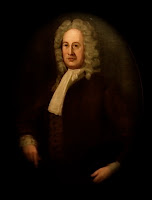On this date way back in 2000, two “e-Masons” founded a discussion group that would wield influence far beyond what anyone could have guessed on that day.
Bro. Josh Heller of Pennsylvania and Bro. Chris McClintock of Ireland had been admins of a group named All Things Masonic, which had a select membership of Freemasons curious about everything from ritual to Rosslyn. On May 8, 2000, after eGroups had been acquired by Yahoo!, the duo launched Masonic Light.
I was not present for the beginning, but found the group during a search of Yahoo! for Masonic groups late one night at the end of January 2001. I was admitted to the Masonic Light group, and nothing for me would be the same.
 |
| The Wayfarer by Hieronymus Bosch, oil on panel, c. 1500. Click to enlarge. |
Discussions were cordial exchanges between Masons with questions and Masons with answers. I tiptoed in during some chat about symbolism found in art. Thinking everyone already knew about what I had to offer, I felt a little foolish telling the group about Hieronymus Bosch’s The Wayfarer, which I had learned of only recently from John J. Robinson’s book A Pilgrim’s Path, which employs the work for its cover art. Painted circa 1500, it shows a man leaving a decadent scene and heading toward a promising future. The initiated eye will discern elements in the painting that are very familiar. (The magpie at lower right is purely coincidental!) Anyway, my modest contribution to the discussion was received with appreciation and wonder. I was hooked.
In 2001, I was in my fourth year as a Master Mason, and I was in a jurisdiction that provided no venue where you could learn anything more than ritual and etiquette. (For the past five years, I am very happily laboring in New York.) Being engaged in the Masonic Light Yahoo! Group was greatly rewarding and, therefore, addictive. I don’t know if the social media we have today were even concepts back then; the ML group communicated through email, and the output could be voluminous. Don’t ask me why I remember this detail, but I recall the month of March 2003 saw more than 3,000 messages shared. That’s a lot. To be clear, there was much friendly banter that leavened the dazzling exchanges of facts and views, but there was hefty substance overall.
The Light that was beamed from all directions and reflected a thousand fold brought together Masons from all over the world, and, more importantly, from jurisdictions of all kinds. There were we mainstreamers, and Prince Hall Affiliation, and PHO, and various female grand lodges, and on and on. There even was a French-speaking man who was part of some self-initiating movement! And we all got along. (Sure there were occasional problems, but harmony prevailed.) We would open a lodge of sorrows upon the death of a member, beginning with the very missed George Helmer.
This was the influential power that I mentioned at the start. By 2002, I was attending AMD Weekend in Washington, DC (now Masonic Week in Virginia), and a large number of us were meeting in person. Janet Wintermute arranged lunches for us at Old Ebbitt Grill. Not only was it great to put faces to personalities, but having our conversations over food and drink, and cigars, whether at the hotel lobby bar or upstairs in the hospitality suites late into the night are fond memories. I’m tempted to name names, but I inevitably will forget someone vital to the experience, so I won’t risk it. Suffice to say a great many leaders, educators, authors, speakers, thinkers, mystics, artists, and other doers found unity in this Masonic Light group, and they have made obvious impacts on Freemasonry in the United States.
This blog was launched, in part, thanks to Masonic Light. There were many late nights I would return home from some amazing event in New York City and, instead of seeking sleep like a wise person, I would sit down at the computer and tell the story of what I had just experienced. Hodapp sometimes would reproduce these missives on the Dummies blog (like here and here), and soon I started blogging on my own.
 |
| Available via Amazon. |
Masonic Light still exists, but last year Yahoo! gutted its groups by eliminating all the web-based features. It’s a shame to have lost years of files and photos we shared, but the elimination of every single message exchanged among ourselves is really terrible. I actually used that massive body of information as reference materials. Some years back, I started a Facebook group for us hoping to recapture the magic, but about two years ago Facebook shut us down, citing its “community standards” bullshit.
But life goes on. Bro. McClintock is working on a new book. The Measure of Light will be a follow-up to his The Craft and the Cross, and will cover more than Freemasonry, such as mythologies, Neolithic stone structures, the Great Pyramids, and more.
Someone in the group at one point coined the term “bristers,” a contraction of brothers and sisters, to use in salutations to all of Masonic Light’s members, so to them all—wherever dispersed about the face of the earth—I say Happy Anniversary, Bristers!































































































